JILT 1999 (1) – Binazzi et al
ITLaw: An Advanced Documentation System in Legal Informatics
Simona Binazzi simona.binazzi@idg.fi.cnr.it
Costantino Ciampi costantino.ciampi@idg.fi.cnr.it
Elio Fameli elio.fameli@idg.fi.cnr.it
Roberta Nannucci roberta.nannucci@idg.fi.cnr.it
Rosa Maria Di Giorgi digiorgi@idg.fi.cnr.it
Giuseppe Trivisonno
Istituto per la documentazione giuridica – CNR, Firenze
1. An Overview of Legal InformaticsIt was immediately after World War II that Lee Loevinger, in his essay ‘Jurimetrics. The Next Step Forward’ (1949) defined jurimetrics as that discipline destined to deal with the problems relating to the relationship between law and new technologies: electronic processing of legal data, use of logic in the legal field and automation of all dimensions of legal activity. From that first definition, through Losano’s giuscibernetica and Frosini’s giuritecnica, descends the expression that is by now accepted usage: legal informatics.
In its Recommendation No. 5/80 on teaching, research and training in informatics and law, approved on 30 April 1980, and in the enclosed Statement of Motives, the Council of Ministers of the Member States of the European Community stated that while computer use is increasing in all sectors of public administration, business and other areas, law students and practicing lawyers are not always sufficiently familiar with this new tool. They lack sufficient knowledge of information science applications available in the field of law, which go from legislative data research systems to text processing to practical applications in the field of judicial administration (…), just as they lack a clear (…) understanding of the informatics tools available for helping solve the legal problems that arise in many daily-life activities (…). From the point of view of the specialists (…), the interaction of informatics and law calls for new methodological skills and new interdisciplinary strategies. We are thus witnessing the growth of an awareness of the fact that traditional legal science must expand to encompass new fields in which automation, informatics and other related technologies each play their role. (…) The expression informatics and law was thus coined to define that field of application spoken of in the Recommendation: the accustomed expression, legal informatics, was felt to be too narrow insofar as it took into consideration only the processing of legal data (…). Computer use raises a whole series of problems that must be regulated by law (…), and for these reasons it was felt that the expression informatics and law better reflected both aspects of the problem.
This is the European Community definition of the discipline, but the expression legal informatics has by now become common usage (while computer law continues to be used to describe questions relating to the social implications of informatics use).
The subject matter takes in, first of all, the applications of informatics in the field of law: storage and retrieval of sources of law, automation of records of public or private interest (respectively: real property registries, registries of births, marriages and deaths; accounting records), automation in law offices and judicial administration. (Frosini, Limone, 1990)
In detail, the discipline deals with a multitude of subjects which may be organized according to a classification system agreed upon by most scholars in the sector and which is re-proposed here following Ciampi’s analysis.
Management informatics (computerized legal and administrative procedures, computer use in the legal professions); parliamentary, administrative, judicial informatics; automated issuance of certificates, automation in the judicial registries, automation in the public registries; informatics tools for trial management.
Documentary informatics (computerized legal documentation): documentation relating to legislation, case law and legal authority; legal databases on mainframe and micro computers; techniques for document analysis, for abstracting, for classification and representation of the contents of legal documents; legal thesauri, telematic video-information services.
Decisional informatics (rationalization and computerization of legal decisions): automated analysis of legal language; formalization of legal language, symbolic logic and law; theory of legal decision-making, techniques for simulating legal and administrative decisions; artificial intelligence and legal reasoning; intelligent data banks; legal expert systems.
The general consensus in international literature is that all those problems having to do with the laws regulating computer use in different areas within society, more precisely those grouped under the heading computer law, are also part of the sphere of legal informatics. In detail, again following Ciampi’s presentation, the subjects included under this heading include: freedom and informatics; computer criminality; contract law in the informatics sector, protection of the new informatics-related property, protection of workers’ rights in the informatics society. A subject area that might be defined as ‘transversal’, insofar as the subjects it addresses are related to constitutional law, to criminal law, to civil, commercial, monetary and tax law, to industrial and intellectual property law, to labour law, thus comes into being. (Ciampi, 1990)
Up to now we have spoken of the sectors in which informatics, as applied in the legal world, can provide a support for the law professional and for the citizen, or final user, alike; we have also mentioned that new level that is termed computer law. We nevertheless feel that, as things currently stand, something more is required of the marriage between informatics and law. An extra effort could lead, as Giannantonio suggests, to the transformation of the very structure of the legal data as the social environment in which the law operates changes and as new research methods are introduced, as well as to modification of those logical procedures used by lawyers in utilizing and evaluating information, and even to rationalization of legal activity itself. (Giannantonio, 1990)
Legal informatics is, then, that science concerned with problems linked to the effective storage, retrieval and transmission of legal data; but it also deals, and from a slightly different perspective, with problems relating to the rationalization of legal activity; within this second grouping, the studies relating to formalization of the legal order (in particular, research in the fields of legal language, formal legal logic and artificial intelligence in the field of law) take on particular importance. Together, the two branches go to make up a discipline capable of producing a sensible impact in the world of law, so traditionally static in its procedures; a discipline that can intervene in the legal office; that, working from the inside, can stimulate awareness of the need to ‘amend’ the legal datum at the very start, at the very moment it is produced, to make it adaptable to the new technologies and so make it possible to achieve more efficacious and more complete results.
Consider, for example, what being able to simulate the effects of the law in different areas of economy and society following new enactments, amendments or repeals could mean; or the infinite possibilities that come to mind when the field of application is legislative technique.
There is a very close relationship between the drafting of a legislative text and the effectiveness of the legal informatics system that will deal with it later. As Pagano observes a propos of Italian legislation (but the reasoning applies, with the appropriate adjustments, to other legal orders as well), it is clear that if our aim is that of creating an optimal legal information system, ex post intervention on the legislative text is not sufficient; that precise choices must be made even as the text is being drafted. Having recourse to non-textual amendments, for example, makes automated updating of the legislative texts a practical impossibility, just as recourse to formulas or means of repeal different from that of express repeal is one of the principal causes of the indeterminacy of the legal order. And the result is that creating a data bank of existing legislation becomes a de facto impossibility.
On the other hand, consider what a boon for the lawmaker had he immediately-accessible specific lists (supplied by his computer) as references for drafting further norms on any given subject: just think of their usefulness in analyzing, re-defining and, it would be hoped, unifying the terminology used for expressing identical concepts in law, or how lists of repealed laws could avoid references to laws no longer in force. Use of ad hoc lists and print-outs could also speed up verification of such amendments as partial repeals, substitutions and additions, and even make it possible to re-formulate entire texts so as to avoid the necessity of continuing to make reference to an original text of which, as more than sometimes happens, only the title has survived. (Pagano, 1990)
The question is one of creating true interaction among the disciplines, to their reciprocal advantage: what will result will be a gradual change in working methods in the legislative offices that can, in turn, influence the legal order itself to reduce its indeterminacy and make it therefore better representable by the informatics system.
One last consideration in this respect concerns the widely-perceived need to create integrated legal information systems . This term stands for systems that can make available to those working in the field of law, whether legislators or law professionals, not only the legislation but also the other sources of law they require for carrying on their work: case law and, in special cases, legal authority as well. (Fameli et al, 1991) (Cammelli, Socci, 1991)
To the above we must add that the legal order with which today’s law professional must contend is constantly increasing in complexity, and as a consequence it is becoming more and more difficult to cope with the new problems using the traditional techniques.
As proof of this it is sufficient to take the example of European Community law, knowledge of which neither legal drafting nor law practice can today do without. Having available electronic supports – databases or more complex information systems – capable of managing such numerous sources of such absolutely different types, from a single workstation, has by now become a basic requirement for the lawyer or legislator, if he is to be able to cope efficiently with the increasingly complex demands of today’s society. (Mital, Johnson, 1992)
As Borruso observes, the work of the law professional can gain in efficacy, can make a ‘quality leap’, if it becomes more methodical, more probing, more critical. Knowledge of the legal order of one’s own country is today no longer sufficient: the jurist must also be familiar with European Community regulations, international agreements, regional laws, even municipal ordinances. All this broadens the field of knowledge out of all proportion and introduces a practically infinite number of variables.
In light of these considerations, how can we, today, even imagine that there could still exist the law professional who, whether out of prejudice or of mistrust, refuses to cross swords with the informatics tools? His very professional standing would suffer by the omission. The emerging new figure is thus very different, perhaps more complete than that to which tradition has accustomed us: what is now required of him is that he establishes an ongoing, interactive relationship with the machine, which can give maximum results only if it is consulted intelligently; and his role must be strongly active, since only through use of a good search strategy will he be able to obtain good results. A good knowledge of law is also needed, ‘especially as concerns the style, the patterns, the nomenclature, the correlations typical of legal science (…); besides imagination, required for envisaging – even before it has been searched and found – the ideal document text which would best represent the subject of the search that has been undertaken and for extrapolating from that imaginary text the data to give the computer for searching for it’. (Borruso, 1990)
Another essential contribution to obtaining truly useful results would appear to come from the systems themselves: friendly, practical, functional interfaces can reduce to a minimum the time required for learning both general system functions and the particular query language used.
Let us conclude with Limone’s interesting definition of legal informatics: legal informatics is a complex of theories, methods and techniques for getting to know, producing, managing, amending, using law, with the aim of guaranteeing the certainty of the law itself, increasing the efficacy of the services offered by the justice establishment, contributing to making of law a special social function promoting the integration, the balance and the cultural evolution of the social system. (Limone, 1990) (Borruso, Tiberi, 1990)
2. Documenting Legal Informatics: The International Bibliography on Computers and Law
Tracing the evolution of this discipline, with all its complexities and its conspicuously interdisciplinary nature, entails certain difficulties: legal informatics has in fact many ties to younger branches of knowledge such as cybernetics and information science, but it is also linked to long-established disciplines such as philosophy and logic. The relationships between legal informatics on the one hand and the technical disciplines on the other are therefore quite varied and complex. The increasing number of studies being undertaken concerning legal informatics and the ever clearer definition of the sectors of competence that are taking shape within the discipline itself have produced copious literature that today makes up an extensive and extremely interesting set of documents.
The Istituto per la documentazione giuridica (idg) of the Italian National Research Council, Florence, has since the 1970s been documenting the development of legal informatics through the publication of studies and research on the subject in its journal Informatica e diritto as well as in its Bibliografia internazionale d’informatica e diritto(‘International Bibliography on Computers and Law’), entitled, since 1992, Information Technology and the Law, which includes the bibliographical references and abstracts relative to books and articles published world over in the specialized journals. From 1998, the same material is published only in electronic format (CD-Rom).
The idea of developing a bibliography on informatics and its applications to the law goes back many years. The first issue of the Bollettino bibliografico d’informatica generale e applicata al diritto was published as a provisional edition in December 1971; by 1972 it had already become a regular periodical publication directed essentially to Italian readers.
The transition from the original Bollettino to the printed version of the Bibliography, which, since 1975, has been regularly published in the scientific journal Informatica e diritto by Le Monnier of Florence and which while concentrating on the same themes as the Bollettino boasted many improvements, was an essential step forward in its evolution.
The fields covered by the Bibliography were redefined to take into account the evolution of studies and research on the subject: the legal informatics framework was now supporting increasingly specific theoretical and methodological research and the development of practical applications. The original cataloguing rules used for describing the bibliographical data were replaced by those commonly accepted in the English-speaking countries, because an international orientation was given to the publication. English replaced Italian as the primary documentary language and as the target language for translation of titles and for the abstracts; the keywords were now also in English. A brief summary, from two to ten lines in length and designed to describe the essential contents of each document, was added to the descriptive elements to help the user decide whether or not to consult the article in full-text form. (Nannucci, 1983)
A thesaurus of terms relating to legal informatics and computer law, completed in 1982, was added as a support to analysis and indexing. Organized by lists, it attempted to standardize the specialized language developed in these fields and to offer the user a guide to understanding of the conceptual organization of the individual descriptors. (Ciampi et al, 1982) (Ciampi et al, 1985)
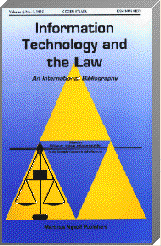 The electronic data processing and printing techniques were refined to bring them into line with advances in technology, and phototypesetting was adopted. Only recently (since 1992) does the Bibliography appear as a new and specialized journal entitled Information Technology and the Law (ITLaw), published biannually by the Dutch international publisher Martinus Nijhoff of Dordrecht.
The electronic data processing and printing techniques were refined to bring them into line with advances in technology, and phototypesetting was adopted. Only recently (since 1992) does the Bibliography appear as a new and specialized journal entitled Information Technology and the Law (ITLaw), published biannually by the Dutch international publisher Martinus Nijhoff of Dordrecht.
Since 1977, the data analyzed for compilation of the Bibliography have been collected in an electronic database called bid, an acronym for the words making up the Bibliography’s Italian title. The bid database currently contains more than 40,000 documents, and an average of 2,000-2,300 bibliographical units are added yearly.
The Bibliography specifically records all documents relating to the application, or the applicability, of computer technology to the law and to the organization of the State as well as to the problems (whether of a legal, sociological, political, economic or educational nature) generated by the impact of the new technologies. The various uses of informatics taken into consideration extend from documentation through management and decision-making; the fields in which computer technology finds these three types of applications are defined as those relative to the making, application and enforcement of the law (automation in Parliament, automation in the Public Administration, automation in judicial administration). In recent years the scope of the bibliography has been broadened to encompass some of those areas in which new developments of interest to legal informatics are taking place, such as artificial intelligence (decision support systems and expert systems), office automation (management information systems) (Fameli et al, 1983) and new hypermedia and hypertext technology
2.3. The International Orientation: The Documentation Centres
The international orientation of the Bibliography merits separate consideration. Since it aims to document literature of world-wide importance, and since it is physically impossible, considering the many distant countries in which documentation originates, to collect all the relevant documentary material in one place, the Bibliography is produced by several of the researchers at the Institute in collaboration of foreign Documentation Centres qualified to cover the most important geographical areas and responsible for bibliographical selection and analysis. Such collaboration is usually coordinated by eminent scholars or experts in legal informatics.
Costantino Ciampi, Elio Fameli and Roberta Nannucci are the researchers involved in the projects since its origin. They were mainly concerned with the organizational aspects and evolutionary developments of the complete work and responsible for the more detailed definition of its content. Simona Binazzi (as editorial assistant), Rosa Maria Di Giorgi and Giuseppe Trivisonno only began working on the Bibliography in 1982. The latter two researchers stopped working on it in 1996.
With regard to the organization of the Documentation Centres, the initial contacts with specialized foreign organizations go back to 1973, the year in which the Norwegian Research Centre for Computers and Law and the University of South Paris began their work. In 1975, the Bibliography organization expanded to include some new centres (Dosir, the Dokumentationsstelle fur Information und Recht, directed by Wilhelm Steinmuller of the University of Regensburg; the Documentation Centre directed by Colin F. Tapper, professor of law at Magdalen College of Oxford University; and that coordinated by Helene Bauer-Bernet, director of the Service Juridique de la Commission des Communautes Europeennes of Brussels); over the years, and in 1982 particularly, the persons in charge of these centers were replaced by others.
The Documentation Centres are presently organized as follows. Analysis of German language specialized literature has been carried out since 1982 by the Buro fur Grundlagenforschung und Systemplanung of Vienna, under the direction of W.R. Svoboda, member of the Computer and Law Society. M. Quenillet and H. Pujol, at iretij in Montpellier, have been responsible for analyzing French-language specialized literature since 1990. Their organization replaced the cnrs which had been collaborating for more than 10 years after it replaced the Institute directed by J.-P. Buffelan in 1975. Documentation from the Eastern European countries has for many years been provided by V. Vrecion of the Charles University of Prague. D. Exell Pirro (European University of Florence) is responsible for the documentation originating in the English-speaking countries (Great Britain, Ireland, North America and Australasia). A collaboration agreement regarding Japanese material was concluded only recently: analysis, performed initially (1988-1992) by Y. Matsumura, of the Hokkaido University, is now being handled by R. Tsuno (Chuo University). The organization expanded again in 1993, when other Documentation Centres were founded: J. Moreiro Gonzales of the Carlos III University of Madrid is responsible for providing Spanish documentation, while A. Schmidt (Leiden University), handles the Dutch documentation. In 1995, Ilya V. Nikiforov, professor at the law faculty of the University of St Petersburg was added and is responsible for scanning the Russian documentation. Italian specialized literature has been analyzed over the years by the ITLaw editors, in collaboration with officials of the Italian Parliament, while, since 1990, Enrico Bisenzi has collaborated on a permanent basis.
The names of the different collaborators who, for more than twenty years, have contributed to the systematic collection of the significant documentary material currently found in the CD-Rom are listed here:
Foreign Documentation Centres
- Dutch Documentation : Aernout Schmidt,1993-
- English Documentation: Colin Tapper, 1975-79; Deirdre Exell Pirro, 1982-
- Eastern Europe Documentation: Vladimir Vrecion, 1982-96
- EEC Documentation: Helene Bauer-Bernet, 1975-79
- French Documentation: Isabelle De Lamberterie,1975-79; Werner Svoboda, 1986-87; Herve Pujol and Martine Quenillet, 1992-95, Deirdre Exell Pirro, 1996-
- German and English Documentation : Wilhelm Steinmuller, 1975-79; Werner R. Svoboda, 1982-
- Italian Documentation: Enrico Zampetti, 1975-79; Rodolfo Pagano,1977-79; Enrico Bisenzi, 1990-
- Japanese Documentation: Yoshiyuki Matsumura,1988-90
- Russian Documentation: Ilya V. Nikiforov, 1995-
- Scandinavian Documentation: Jon Bing, 1975-90, Patrik Hiselius, 1992; Leif Skuterud, 1993-94; Viggo Elster, 1996-97
- Slovenian Documentation: Arne Mavcic, 1995-96
- Spanish Documentation: Jose A. Moreiro Gonzales, 1993-
Production of a bibliography of the kind described here involves a number of complex operations, each of them must be carried out by following the precise working procedures and criteria that have been defined gradually, step by step, over the years. Analysis of source materials and document selection are the most delicate phases in the life cycle of the bibliography, since it is the choices made by the documentalists in these phases that will determine not only whether the information included in the Bibliography is relevant and topical but also whether or not it is consistent. Thus the more care is devoted to collecting the material to be scanned, the more comprehensive and useful will be the Bibliography.
Source identification. A total of about 300 specialized journals published in various parts of the world are selected each year. Books and booklets, proceedings of conferences and congresses and collections of articles and essays are also included in the Bibliography, as are some other types of documents such as research papers originating with private organizations, public bodies, institutes, universities, foundations, etc.; that is, all material falling under the heading of ‘grey literature’. The specialized series on legal informatics now being produced by both Italian and foreign publishers are also regularly scanned, the same way as secondary sources such as abstract journals and on-line bibliographical databases are. (Di Giorgi, 1986) (Di Giorgi, Binazzi, 1987) Finally, with the development of Internet as a source, the number of documents that can be retrieved on the net are constantly increasing.
Selection. A general principle for selection of relevant material has been established: the contents of the documentary unit being considered for inclusion in the Bibliography must be compared with the headings of the Classification Table. The principle extends to identification of a dual level of relevance of the data to the central themes covered by the Bibliography. The first level is that of the theoretical and applied aspects of legal informatics and the legal, sociological, political, educational and economic problems arising around legal informatics and automation in general; the second level considers practical applications and scientific developments in fields and disciplines of significance to the legal community. Since this rule aims at gradually concentrating the bibliographical material around topics of certain relevance to legal informatics, its application has in practice led to the introduction of a second principle entailing analysis, by which only the bibliographic citations of those documents judged to be most relevant are completed by addition of a brief summary of their contents.
Description and analysis . While it will suffice here to say that description of the selected documents follows the general rules of bibliographic cataloguing, their analysis, of which the abstract is the basic expression, merits some further attention. Experience has suggested that the abstract should conform to certain precise criteria as regarded both formal expression and content. Natural language (expression in simple but completed periods) was preferred over telegraphic expression devoid of syntactic structure; the phrasing, wherever possible, should be impersonal, and empty words (words with little significance and unnecessary adjectives) carefully avoided. And brevity – or balancing the incisiveness of the summary, the length of which cannot exceed a predetermined number of words, against the length of the original document – is essential.
Descriptors. Keywords were included to aid the user in searching. They were selected after careful study of the technical terminology recurring throughout the vast and heterogeneous literature on legal informatics. Years of study of the uniformity of this terminology, of the many uncertainties surrounding it and of the significant linguistic problems it poses have gone into building a true thesaurus of emerging terminology. Thes/Bid, edited by C. Ciampi, E. Fameli and G. Trivisonno and published in English in 1982 and in Italian in 1983, is an indispensable reference work for the user and an essential support aid for the documentalist. In the light of the electronic publication of the Bibliography, terminology which, over the years, had been developing and becoming consolidated, was added to the Thesaurus and was made available in a six-language version (Italian, English, French, German, Spanish and Portuguese).
Printing . Special programs contain all the instructions necessary for text management and processing (ordering the data and creating the lists in programmed sequence) and for phototypesetting the final graphic form. Such sophisticated techniques guaranteed high graphic resolution and a considerable saving in the time required for printing as long as the final text was to be delivered to the publisher in camera-ready copy.
Master copy . With the passage of the Bibliography from the printed version to that on CD-Rom, all the computer procedures suitable for producing the master copy and for its copying have been perfected.
As informatics has evolved so has it become necessary to update bibliography management techniques. A series of support files, containing information on both the functional organization of the bibliography (document flow and document centres production times, financial management, users addresses) and the support tools for documentary activity (the thesaurus of legal informatics and the list of sources), have been created. The latter two files are updated on the basis of information supplied by the documentation centres and appraisals by the editorial staff. In the case of the sources file, updating involves analysis of the bibliographical lists of specialized publishing houses and research institutes as well as those provided by the world’s most important libraries. On-line access to the databases of the library of the Istituto per la documentazione giuridica, one of largest and most complete collections in the world in the domain of legal informatics, is also provided.
2.6. A Software for Automated Data Input
Since 1991, the Documentation Centres have been using specially-developed pc-based software, called bid/input (bin), which allows the Centres to input the bibliographical data automatically so that their material can be supplied directly on magnetic support ready for processing and distributing later.
The information contained in each record is of three basic types: that providing a material description of the document (document type, bibliographical details), a description of the document (author, title and subtitle, source language), and an analysis of the document content (classification code, abstract, keywords).
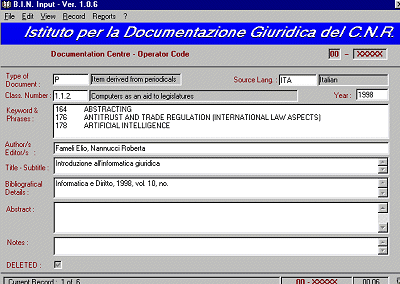 |
A special software for simplifying data acquisition and for standardizing reproduction was developed for use in describing the various bibliographical elements relating to each document; the same program also inserts all the control characters required for automating the bibliography.
In fact, the pre-printed form for data description has been replaced by an automated form: each window which make up the electronic form is programmed to receive the descriptive elements of the document being analysed.
The Documentation Centres collaborating with the Institute in the production of the bibliographic material provide the data directly on floppy disk. Processing of the bibliographical data acquired in this way is handled by the same company that sees to its phototypesetting for the printed publication of the Bibliography, producing three types of output: on magnetic tape for utilization in the host computers of the most important information networks, on paper for publication purposes, and on floppy disk.
The analysis and classification phase of the document is greatly optimized, as the documentalist has access to a series of dictionaries and lists that aid him in compilation of the records. The documentalist accesses the lists by placing the cursor in the relative windows of the form that appears on the screen: in accordance with the particular case, one of the following appears: the abbreviation or the number for the original language, the type of document, the classification table, the title of the journal and the key words. The decision to use numerical codes instead of the terms which make up the key words was dictated by obvious considerations of memory space.
Each list is made up of abbreviations or numerical codes followed by their breakdown. Each of these lists may be searched by word, by expression and by classification code, with all the masking alternatives. The documentalist then selects the suitable expression or code and assigns it; so, the relative field is completed in real time.
Obviously, what is not automatic about the system is that part pertaining to the text of the abstract, which the documentalist must type into a ‘memo’ field. Another ‘memo’ field is also available where the documentalist can include the notes and observations he wishes to submit to the attention of the editors of the Bibliography.
When indexing, the documentalist will consult the Thesaurus. It has many types of access to make both searching and subsequent selection of the opportune descriptive expressions as efficient as possible. The documentalist can scroll the descriptor list in alphabetical order, or use Boolean operators to retrieve complete descriptors or the single words comprising them. Thanks to an inverted descriptor index (the kwoc index) in the program, it is also possible to perform a word search within the descriptors and retrieve all those descriptors containing a specific word. Once a descriptor has been selected, it is assigned to the document; the number identifying the descriptor will be displayed in the keyword window on the bibliographical record. ( Binazzi et al, 1991)
In 1998, following the decision to no longer publish the International Bibliography of Information Technology and Law(ITLaw) in print form but on CD-Rom, the electronic data input software was transferred into Windows and enriched with the additional functions that this environment makes possible (data import and export, automatic spelling checker, dictionary of authors and journals).
The new data input program also has a menu which aids the documentalist in his task of compiling the bibliographical forms according to the rules defined over the years relating to the harmonization of the data.
3. Disseminating the International Bibliography
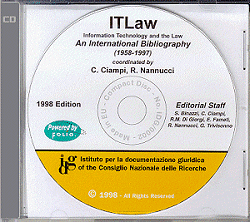 The dissemination of an International Bibliography can currently avail itself of advanced technology which reduce costs to a minimum and, at the same time, considerably increase the ways and means of accessing information. In consideration of this, from 1998, the International Bibliography of Information Technology and Law has ceased publication as a printed journal and is published as a CD-Rom for local consultation and as an on-line database for consultation on the net.
The dissemination of an International Bibliography can currently avail itself of advanced technology which reduce costs to a minimum and, at the same time, considerably increase the ways and means of accessing information. In consideration of this, from 1998, the International Bibliography of Information Technology and Law has ceased publication as a printed journal and is published as a CD-Rom for local consultation and as an on-line database for consultation on the net.
3.1. The Bibliography in its Printed Edition
In the printed edition of the international journal Information Technology and the Law the material of the Bibliography has been organized in three lists, cross-referenced by codes: the keyword index, the bibliography and the author index.
The bibliography is the main index: it contains complete bibliographical details of each entry analysed and a short description of its content added in English by the documentalist. The documents are arranged by subject in accordance with a specially-created decimal Classification Table and are ordered according to an alphanumeric code which refers the user from the Keyword or Author index back to the Bibliography for full information. The code is in two parts. The first part consists of a six-figure code, used to codify document content and to order the entries in accordance with the six levels of the Classification Table. The second part of the code, containing the four-figure serial number of the entry, precedes the name of the author/s. There follows a letter code identifying entry source type.
The keyword index is an automated list of relevant words or combinations of words used as descriptors of the contents of retrieved documents. The keywords are listed in alphabetical order as headings on the left-hand side of each printed page. The titles of pertinent documents, complete with the English translation and the alphnumeric code which identifies the document and refers the user to the systematic Bibliography are displayed under each keyword. The Keyword Index is created using the kwoc (Key Words Out Context) indexing technique, by which keywords are printed as headings in the left-hand margin of the page and above the complete titles of the documents to which they refer. Keywords to be applied are those contained in thes/bid.
The author index is a list, in alphabetical order, of all the authors or editors of documents contained in the Bibliography; each index entry is flanked by alphanumeric codes referring the user to entries in the Bibliography. The authorship of court decisions is attributed to the deciding court; that of legislative instruments to the issuing legislative body.
3.2 The Bibliography on CD-Rom
Compared to the printed version of the Bibliography, the CD-Rom provides the user with many advantages: on the one hand, it is now possible to simultaneously consult a huge mass of data (the entire database includes more than 40,000 documentary units) whilst, on the other, the quality of the information which can be obtained appears to be greatly enhanced thanks to the multitude of hypertext links made possible through particularly advanced and sophisticated software now available (FolioViews 4.11. was used for this documentary experience).
The infobase is composed of the Author Index, the Keyword Index, the Classification Table, the Thesaurus and the Bibliography itself in descending chronological order (from the most recent to the oldest). Apart from carrying out a search within each of these indexes, the system allows the user to navigate from one index to another through conceptual associations.
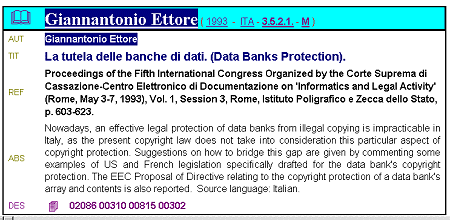 |
The links that can be established among the single pieces of information contained in a bibliographic database are quite numerous, and their organization by type would seem to provide a highly functional response to users’ often very different needs. (McAleese, Green, 1990) (McGrew, McDaniel, 1989)
The fact that there exists a specialized thesaurus on the subject that is intrinsically linked to the database – each of the descriptors in the Thesaurus refers to particular documents – allow to make use, in this application, of a model (explicit) which has already been used experimentally for other specialized legal databases. We can, in fact, create a metalevel over the documents, called the hyperconcept, made up of the set of nodes containing the single descriptors from the thesaurus. This network of links interacts with an underlying level, that of the hyperdocument, made up of the set of nodes that make reference to the single documentary units in the Bibliography. By applying the same management scheme used for organizing the relationships within the thesaurus (hierarchical relationships, relationships by association, by synonymity, etc.) to the relationships among the bibliographical documents, which are connected by descriptors through the hypertext links , we expect to make navigation within the system, between the two levels, a highly complex and rewarding experience and a highly efficient tool for information retrieval: each descriptor found in a document also has its precise place within the semantic network that organizes the thesaurus. When a descriptor is used as a key for accessing the document base, the other descriptors included in each document and in turn linked to the first descriptor chosen can be used to access a cluster of documents which are semantically linked to the first document retrieved.
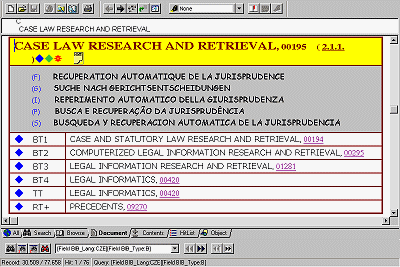 |
The possibility of mapping search paths allows the user to gradually refine his information retrieval strategies, considerably widening the associative capacities of the system and in this way guaranteeing results which could not be achieved before. (Agosti et al, 1989) (Di Giorgi, Nannucci, 1992)Four tables have been added here in order to better represent the major characteristics of the complete database, presently consisting of 41,401 bibliographical units deriving from different contributions published in about 16 source languages in 30 countries located in Europe, America, Australasia and Japan.
Tab. 1 shows the distribution of documents according to the source language distinguishing between documents deriving from periodicals and documents belonging to the other tipologies, which are the minor part. Even if languages have been grouped as per linguistic geographic areas, it is apparent that Italian represents almost 1/3 of English and 1/2 of German. It partly corresponds also to the evolution of the domain, that is legal informatics: Developed especially in the USA it consolidated itself firstly in highly technologically developed countries. Documents in Scandinavian languages (Swedish, Norwegian, Dutch and Finnish), Iberian (Spanish and Portuguese) and Asiatic (Japanese) are an unsignificant entity.
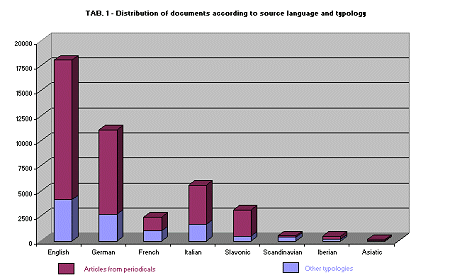 |
Table 1: Distribution of documents according to source language & typology
Tab. 2 represents the evolutionary trend of documentation in the field of legal informatics from the origin (fifties) to nowadays. The English and German realities have had a more rapid development starting from the sixties, while the other geographical areas faced with a very slow and almost constant development.
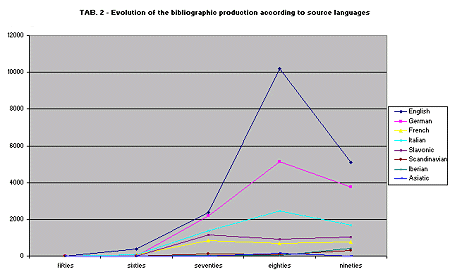 |
Table 2: Evolution of the bibliographic production according to source languages
Tab. 3 represents the distribution of documents according to their tipology. Articles derived from specialized periodicals represent the 70% of the total amount, followed by miscellaneous works and books. Judicial decisions and legislation represent a very little percentage, as they have been considered relevant only in the last years.
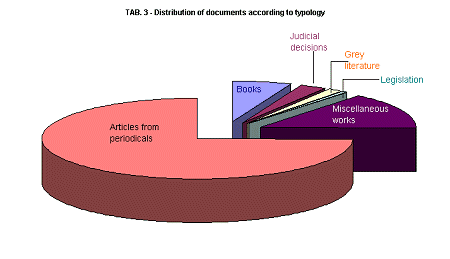 |
Table 3: Distribution of documents according to typology
Tab. 4 refers to the systematic distribution of the documents included in the
infobase
and in a way completes the view of Tab 2. Almost the fifty % of documents
belongs
to Class 3 of the Classification Table, that
is refers
to
law
governing informatics, while only 15% belongs to class 1, relating to the applications of informatics in the Public
administration
. 13% refers to Class 4, that
is relates
to sociological, political, economic and educational aspects introduced by the impact of informatics on the society. Less than 1% covers the most theoretical aspects.
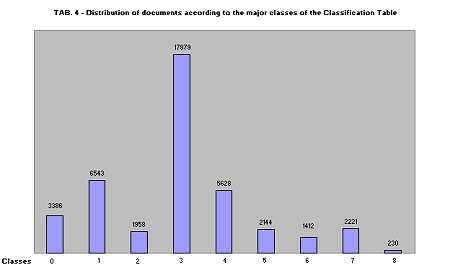 |
Table 4: Distribution of documents according to the major classes of the Classification Table
3.3 The On-Line DatabaseTwice a year the Istituto per la Documentazione Giuridica provides the Documentation Centres of the Italian Supreme Court and Chamber of Deputies with a copy of the data relative to the updating of the Bibliography (about 2,000 documents per year). The mixed language indexing technique with which the documents are stored in the BID database allows the user to search the database using both the natural language of the abstract and the artificial language of the keywords assigned to each document.
Since 1982 a database called thes/bid can be consulted in the information systems of the Italian Supreme Court and Chamber of Deputies. It contains the entire thesaurus of keywords created for document indexing. thes/bid can be searched semantically to single out the relevant descriptors for each subject area, or in more detail, for the particular topic handled during a given search session. Once the semantic access keys have been individuated, they may be exported and used in consultation of the database. Each document is indexed with at least three or four descriptors taken directly from the Thesaurus.
The advantages, in terms of retrieval efficiency, of using the Thesaurus are so plain that further discussion would be superfluous; but, obviously, full-text searching of the entire document base is always possible.
The database will also be distributed soon on Internet, the world’s most widely-distributed scientific data network, using the special FolioViews interface. It will, therefore be possible, for any user, no matter where he is, by linking up to the Institute’s site, to access information in it.
Agosti M, Archi A, Colotti R, Di Giorgi R M, Gradenigo G, Inghirami B, Mattiello P, Ragona M (1989) New Perspectives in Information Retrieval Techniques: A Hypertext Prototype in Environmental Law, in Proceedings of the Third International Conference on ‘Online Information 89’, Oxford, Learned Information, 1989, 483-494.
Binazzi S, Ciampi C, Fall J, Nannucci R, Righini R, Trivisonno G (1991) BIN – Bid INput, Istituto per la documentazione giuridica del CNR, Florence, June, 1991, 14.
Borruso R, Tiberi C (1990) L’informatica per il giurista, Milano, Giuffre, 1990, 314.
Borruso R (1990) L’informatica giuridica come materia di studio autonoma, in V Frosini, D A Limone (eds) L’insegnamento dell’informatica giuridica, Naples, Liguori, 1990, 29-51.
Cammelli, Socci (1991) Caratteristiche e finalit… di un sistema esperto nel diritto: proposta di un sistema esperto giuridico integrato, in ‘Informatica e diritto’, XVII (1991), 1-3, 185-194.
Ciampi C, Fameli E, Trivisonno G (1982) THES|BID. A Computer-based Thesaurus of Therminology in Computers and the Law, in ‘Informatica e diritto’, VIII (1982), 1, XIII +575.
Ciampi C, Exell Pirro D, Fameli E, Ricci S, Trivisonno G (1985) THES|BID: An Expert System for Constructing a Computer-based Thesaurus for Legal Informatics and Computer Law, in C Walter (ed), Computing Power and Legal Reasoning, West Publishing Co, 1985, 375-412.
Ciampi C (1990) Dall’alfabetizzazione informatica all’insegnamento dell’intelligenza artificiale nelle facolt… di giurisprudenza. Esperienze e prospettive, in V Frosini, D A Limone (eds) L’insegnamento dell’informatica giuridica, Naples, Liguori, 1990, 67-75.
Di Giorgi R M (1986) L’informatica giuridica e il diritto dell’informatica. Le riviste e le bibliografie, in ‘Informatica e diritto’, XII (1986), 3, 179-216.
Di Giorgi R M, Binazzi S (1987) L’informatica giuridica e il diritto dell’informatica. Le riviste e le bibliografie. Tavole statistiche, in ‘Informatica e diritto’, XIII (1987), 3, 173-186.
Di Giorgi R M, Nannucci R (1990) Recent Trends in Legal Bibliographical Documentation, in ‘Computers and the Humanities’, XXIV (1990), 5-6, 437-443.
Di Giorgi R M, Nannucci R (1992) A Legal Hypertext System Prototype, in C.A.F.M. Grutters, J.A.P.J. Breuker, H.J. van den Herik, A.H.J. Schmidt, C.N.J. de Vey Mestdagh (eds.), Legal Knowledge Based Systems, JURIX ’92, Lelystad, 1992, Koninkijke Vermande BV, pp171-178.
Fameli E, Nannucci R, Di Giorgi R M (1983) Documentation in Legal Informatics and the ‘International Bibliography on Computers and Law’, in ‘Informatica e diritto’, IX (1983), 3, 183-239.
Fameli E, Di Giorgi R M, Nannucci R (1991) Expert Systems and Databases: A Prototype in Environmental Law, in ‘Informatica e diritto’, XVII (1991), 1-3, 227-247.
Frosini V, Limone D A (eds) (1990) L’insegnamento dell’informatica giuridica, Naplesi, Liguori, 1990, p166.
Giannantonio E (1990) L’insegnamento dell’informatica giuridica nell’universit…. L’esperienza della LUISS, V Frosini, D A Limone (eds) L’insegnamento dell’informatica giuridica, Naples, Liguori, 1990, 89-93.
Limone D A (1990) L’insegnamento dell’informatica giuridica in Italia, in V Frosini, D A Limone (eds) L’insegnamento dell’informatica giuridica, Naples, Liguori, 1990, 19-27.
McAleese R, Green C (1990) Hypertext: State of the Art. Part 1: Navigation and Browsing, Oxford, Intellect, 1990.
McGrew P C, McDaniel W D (1989) On-line Text Management. Hypertext and Other Techniques, New York, MacGraw-Hill, p242.
Mital V, Johnson L (1992) Advanced Information Systems for the Lawyers, Cambridge, University Press, 1992, p306.
Nannucci R (1983) BID Compilation Rules, Istituto per la documentazione giuridica del CNR, Florence, 1983, 89.
Pagano R (1990) L’insegnamento dell’informatica giuridica nella scuola superiore di scienza e tecnica della legislazione dell’ISLE, in V Frosini, D A Limone (eds) L’insegnamento dell’informatica giuridica, Naples, Liguori, 1990, 95-99.
This is a Conference Paper published on 26 February 1999.Citation: Binazzi S et al, ‘ITLaw: An Advanced Documentation System in Legal Informatics’, Conference Paper, 1999 (1) The Journal of Information, Law and Technology (JILT). <http://elj.warwick.ac.uk/jilt/99-1/binazzi.html>. New citation as at 1/1/04: <http://www2.warwick.ac.uk/fac/soc/law/elj/jilt/1999_1/idg/binazzi/>

